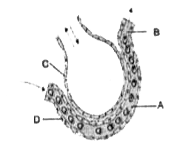Olfactory epithelium develop from
Embryonic endoderm
Embryonic ectoderm
Embryonic mesoderm
Embronic mesenchyme.
The correct Answer is:B
To determine the origin of the olfactory epithelium, we can follow these steps:
1. Identify the Options: The question provides four options regarding the embryonic origin of the olfactory epithelium:
- A) Embryonic endoderm
- B) Embryonic ectoderm
- C) Embryonic mesoderm
- D) Embryonic mesenchyme
2. Understand the Germ Layers: In embryonic development, there are three primary germ layers:
- Ectoderm: This layer gives rise to the nervous system, skin, and sensory organs.
- Endoderm: This layer forms the lining of the gut and other internal organs.
- Mesoderm: This layer contributes to muscles, bones, and the circulatory system.
3. Focus on the Ectoderm: Since the olfactory epithelium is involved in the sense of smell and is part of the sensory system, it is crucial to identify which germ layer is responsible for sensory organs.
4. Link to Olfactory Epithelium: The olfactory epithelium contains sensory cells that have odorant receptors. These sensory cells are derived from the ectoderm, which is responsible for developing nervous tissue and sensory organs.
5. Conclusion: Based on the information about the germ layers and their derivatives, the olfactory epithelium develops from the embryonic ectoderm.
Final Answer:
The olfactory epithelium develops from B) Embryonic ectoderm.
---
- A) Embryonic endoderm
- B) Embryonic ectoderm
- C) Embryonic mesoderm
- D) Embryonic mesenchyme
- Ectoderm: This layer gives rise to the nervous system, skin, and sensory organs.
- Endoderm: This layer forms the lining of the gut and other internal organs.
- Mesoderm: This layer contributes to muscles, bones, and the circulatory system.
The olfactory epithelium develops from B) Embryonic ectoderm.
Topper's Solved these Questions
Similar Questions
Siliqua develops from
View SolutionType of neurons with a single process arising from cyton which divides later to form an axon and a long dendron are found in
(a) Olfactory epithelium and cochlea
(b) Grey matter of brain
(c) Sensory dorsal roots of spinal cord in ganglion
(d) Motor ventral roots of spinal cord
View SolutionOlfactory Epithelium (Scheneidarian membrane) is composed of : -
View SolutionRoot hairs develop from
View SolutionColumnar epithelium differs from cuboidal epithelium in that
View SolutionIdentify simple squamous epithelium of alveolus from the following diagram.

View SolutionMatch the column I with column II
Column -IColumn-IIa.Horizontal and amacrine cell(i)Pivot pointb.Incus(ii)Olfactory epitheliumc.Bowman's gland(iii)Retinad.Cupula(iv)Crista(v)Macula
View SolutionMango develops from –
View SolutionGland associated with olfactory epithelium are
View SolutionRead the following statements, br (a)Unipolar neurons are found in retina of eye and olfactory epithelium, br (b) Except microglial cells, all cells of nervous tissue develop from ectoderm, br (c) Astrocytes and neurolemmocytes perform functions like phagocytosis and providing nutrition to the neurons respectively, br (d) Unmyelinated neurons are commonly found in autonomous neural system, br Choose the option which includes correct statements only,
View Solution
